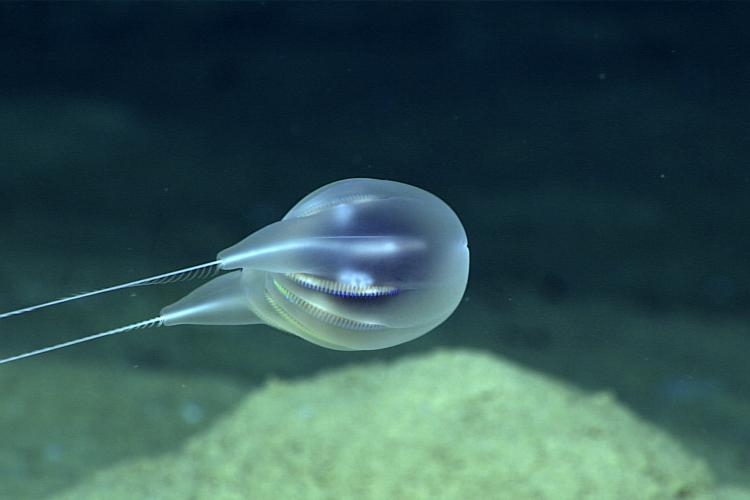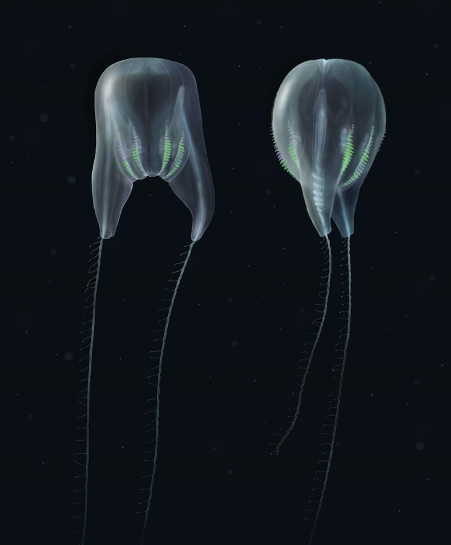Newfound marine blob looks like 'party balloon' with two strings, scientists say
This is the first species NOAA scientists have ever discovered from video footage alone.

Deep in an underwater canyon off the coast of Puerto Rico, there's a party of balloon-like sea creatures keeping things festive in the abyssal depths.
Their bodies are small — about the size of a golf tee (just over 2 inches, or 6 centimeters, long) — but they're vibrant; when the creatures move and pulse, rows of tiny hair-like cilia refract light into a prism of shining colors.
Researchers at the National Oceanic and Atmospheric Administration (NOAA) first spotted these mysterious party blobs in 2015, sighting three of them near the seabed at a depth of roughly 13,000 feet (4,000 meters). Now, in a paper published Nov. 18 in the journal Plankton and Benthos research, the team has identified the blobs as a new species of ctenophore –- tiny invertebrate predators also known as comb jellies or "sea walnuts" –- called Duobrachium sparksae.
Related: 8 Crazy facts about octopuses
While their wee bodies and shimmering cilia are traits commonly shared among the 100-plus known ctenophore species, the Puerto Rican party blobs still represent an exciting first in marine biology. According to the researchers, this is the first underwater species NOAA researchers have ever described from pictures alone; the team had no access to physical samples for their new study.
"The cameras on the [remotely operated] Deep Discoverer robot are able to get high-resolution images and measure structures less than a millimeter," study co-author Allen Collins, a NOAA fisheries scientist, said in a statement. "We don't have the same microscopes as we would in a lab, but the video can give us enough information to understand the morphology in detail."
Despite their name, comb jellies are not related to jellyfish, though they do share a similar gelatinous appearance. D. sparksae is no exception, with eight rows of prickly cilia wrapping around a translucent body. That body ends at two points attached to long, thin tentacles, giving the creature an appearance like a floating balloon with two "dangly bits," each attached to its own string, Collins said.
Sign up for the Live Science daily newsletter now
Get the world’s most fascinating discoveries delivered straight to your inbox.

One of the three specimens the team encountered seemed to be "anchored" to the seafloor by its tentacles, the researchers wrote. Using a pair of lasers on their underwater robot, the researchers measured the approximate length of that specimen's body and tentacles, finding the tentacles to be roughly five times as long as jelly's body (each tentacle was 12 inches, or 30 cm, long). When the jelly moved, it moved "like a hot air balloon," maintaining a specific altitude above the ocean floor, said lead study author Michael Ford, also of NOAA.
Many questions remain about these elusive, deep-sea jellies, including what role they play in their ecosystem. More video footage of the blobs will provide additional clues, but to conduct a crucial DNA analysis researchers will have to get their gloves on an actual intact specimen. That may be easier said than done, as jelly-like animals have a very short shelf-life outside of the deep sea, the researchers said.
"Even if we had the equipment, there would have been very little time to process the animal because gelatinous animals don't preserve very well; ctenophores are even worse than jellyfish in this regard," Collins said. "High-quality video and photography were crucial for describing this new species."
Originally published on Live Science.

Brandon is the space/physics editor at Live Science. His writing has appeared in The Washington Post, Reader's Digest, CBS.com, the Richard Dawkins Foundation website and other outlets. He holds a bachelor's degree in creative writing from the University of Arizona, with minors in journalism and media arts. He enjoys writing most about space, geoscience and the mysteries of the universe.









